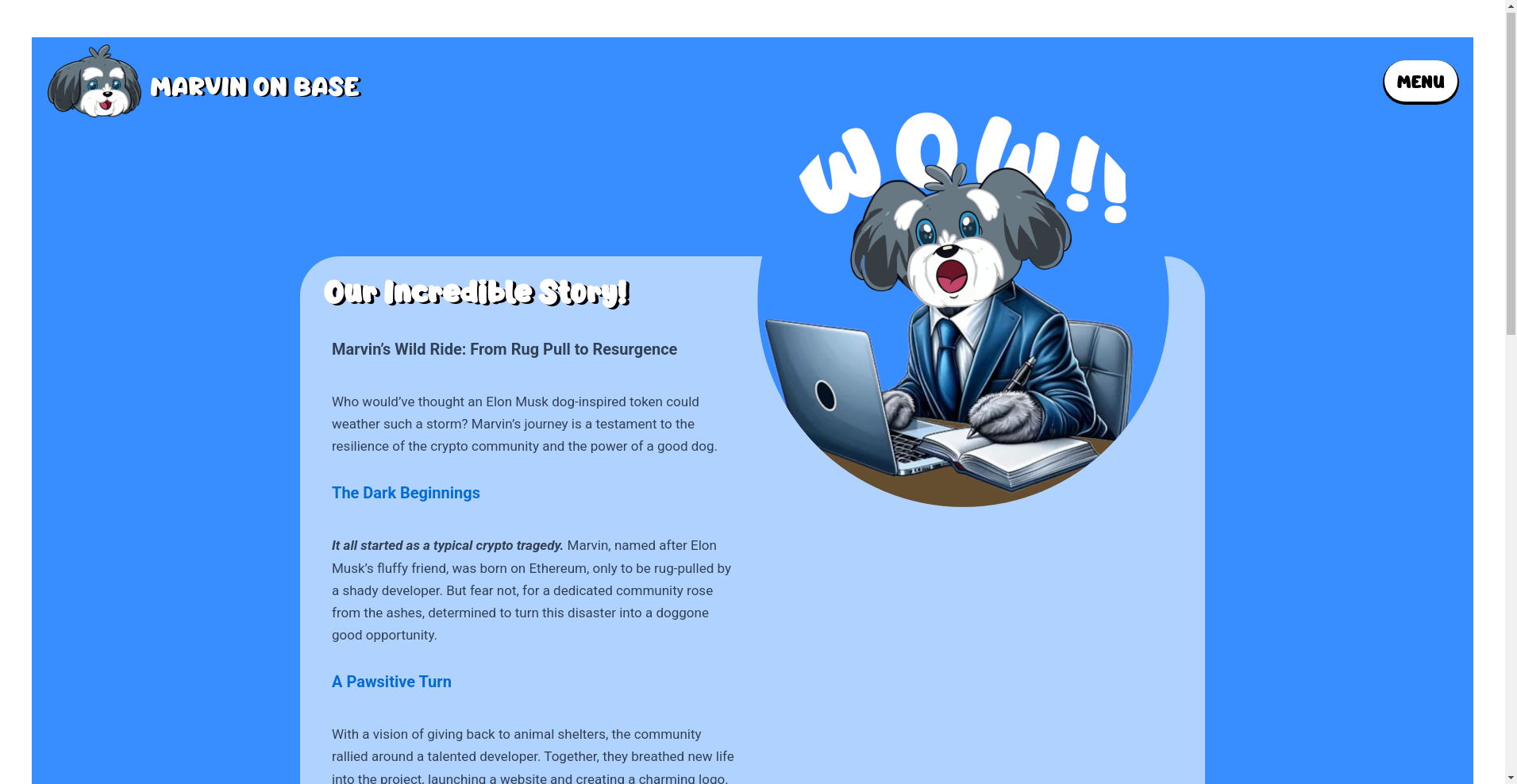Marvin ($MOB) Review: A Data-Driven Look at Its Legitimacy, Risks, and Potential

What Is Marvin: An Introduction
Marvin is a community-driven meme token launched on the Base network, positioning itself as a utility-focused project aimed at rescuing gas-trapped tokens with its innovative DAPP, the Marvin Trust Bot. The project emphasizes strong community engagement, social impact through charity initiatives, and utility features such as bridging and swapping. Marketed as more than just a typical meme coin, Marvin seeks to establish a recognizable presence within the Base ecosystem.
This review provides an impartial analysis of Marvin’s core attributes, examining its legitimacy, security posture, tokenomics, and development trajectory to help potential investors and stakeholders evaluate its long-term viability and inherent risks.
The Team and Vision Behind Marvin
Based on publicly available data, the Marvin project does not prominently reveal its team members’ identities. This lack of transparently disclosed leadership can be viewed as a common feature among meme tokens, magnifying the importance of scrutinizing the project's credibility through other indicators.
The project's narrative describes overcoming significant hurdles such as a previous Ethereum-based rug pull, community resurgence, and strategic migration to the Base network. This resilience suggests a committed community and a motivated development team, though the absence of detailed background information on key contributors warrants cautious optimism.
- Completed Launch on Base with active social media channels, notably Twitter and Telegram.
- Clear roadmap with phased goals focusing on ecosystem growth, partnerships, and exchange listings.
- Recent community milestones include expanding social followers and establishing utility through the Trust Bot.
In terms of delivery capability, the project’s milestones indicate an organized approach with tangible achievements. However, the lack of detailed team credentials and real-world investor backing makes it challenging to fully assess long-term execution risks.
Assessing the Security and Integrity of Marvin
The security analysis for Marvin is primarily based on the Cyberscope audit report, which examines the smart contract vulnerabilities and overall code integrity. While the project has undergone an audit, the scope and depth of the assessment should be critically evaluated.
The Cyberscope audit reveals that Marvin’s smart contract on the Base network has passed an external security review, with a high security score of 89%. This indicates that the code was free from critical vulnerabilities at the time of audit, and the contract was deployed with sufficient safeguards in place.
- Audit assessed token contract coding standards; no critical vulnerabilities reported.
- The contract is renounced, meaning ownership privileges are relinquished, reducing centralized control concerns.
- While the audit results are promising, the audit was conducted on a specific contract; other parts of the project, such as the Trust Bot or community mechanisms, lack formal security reviews.
- Decentralization score is approximately 35%, indicating moderate centralization, which could impact trustworthiness or change control.
Overall, the security posture appears robust at a technical level. Nonetheless, investors should remain aware of potential social vulnerabilities—such as the risk of social engineering or community manipulation, which are common risks in meme-oriented projects lacking extensive third-party security endorsements.
A Breakdown of Marvin Tokenomics
The tokenomics of Marvin ($MOB) features a total supply of approximately 1.2 billion tokens, with almost 20% already burned, reducing total circulating supply and attempting to create scarcity. The token is designed with a 0% buy and sell tax, which could encourage trading activity and liquidity mobility.
- Total Supply: ~1,207,598,723,478 MOB
- Burned Tokens: ~20% of initial supply eliminated
- Liquidity: Liquidity Pool (LP) locked, contract renounced
- Vesting & Allocation: No detailed vesting schedule publicly provided for team, investors, or charity allocations
- Utility: The token powers the Trust Bot, community engagement, and charity initiatives, but lacks core DeFi features like staking or yield farming
The economic model appears designed to foster organic growth via community engagement rather than financial incentives, which aligns with their charitable and utility-driven branding. However, the absence of vesting or formal lock-up terms introduces potential risks of token dumps, especially if the community and project fail to achieve widespread adoption or face market shock.
Assessing Marvin's Development and Ecosystem Activity
Development activity, according to available data, is active, with continuous updates on social media, progress milestones, and ecosystem integrations. The project has successfully launched its utility (Trust Bot), achieved listings on CoinGecko and CoinMarketCap, and secured partnerships with animal shelters, underlining genuine community-driven progress.
While these activities demonstrate genuine development effort, much of the project’s growth appears rooted in marketing and community hype typical of meme tokens. Evaluating the true utility of these meme tokens is crucial; merely tracking code commits or infrastructure updates isn’t sufficient; sustained ecosystem expansion, such as additional utilities or integrations, will be essential to establish long-term traction.
In sum, Marvin’s development shows commitment, but the project's future trajectory will heavily depend on its ability to transition from hype to utility and real-world use cases beyond community engagement.
What Investors Should Know About Marvin's Legal and Terms Framework
Marvin’s website prominently features a detailed disclaimer emphasizing the high-risk nature of meme currencies. There are no indications of comprehensive legal frameworks, licensing, or formal KYC procedures beyond the KYC requirement for fiat purchase methods.
Noteworthy points include:
- No explicit legal protections or dispute resolution mechanisms mentioned.
- High volatility inherent to meme tokens and reliance on social sentiment.
- Potential for social engineering or pump-and-dump schemes given the project’s community-centric approach.
Investors should be aware that, in the absence of formal legal safeguards or clear regulatory standing, the risk profile remains high. The project’s emphasis on charity and community engagement does not mitigate the financial risks associated with volatile tokens.
Final Analysis: The Investment Case for Marvin
Marvin stands out as an ambitious meme utility token that leverages community resilience, social engagement, and technical efforts like security audits. Its core utility—rescuing gas-trapped tokens through the Trust Bot—addresses a genuine pain point for crypto users, which could foster lasting user adoption. Its transparency efforts (contract renouncement, locked liquidity, audit report) add credibility, though the project's non-disclosure of team identities introduces inherent risks.
However, the project’s reliance on social sentiment, typical of meme tokens, remains a significant risk factor. Price volatility driven by hype, speculative trading, and social media manipulation can undermine its stability. Moreover, the moderate decentralization score and minimal formal legal protections heighten vulnerability to market manipulation and regulatory shifts.
In conclusion, Marvin ($MOB) exhibits promising signs of community engagement and technical robustness, but its long-term success hinges on sustained utility development, ecosystem expansion, and community trust. As with all high-risk cryptocurrencies, potential investors should conduct thorough due diligence and only allocate funds they can afford to lose.
Overall, Marvin’s prospects remain speculative, but with targeted growth and transparent operations, it can carve out a niche within the Base ecosystem. Continuous monitoring of development milestones, security posture, and market dynamics will be vital for assessing its ongoing legitimacy and risk profile.
